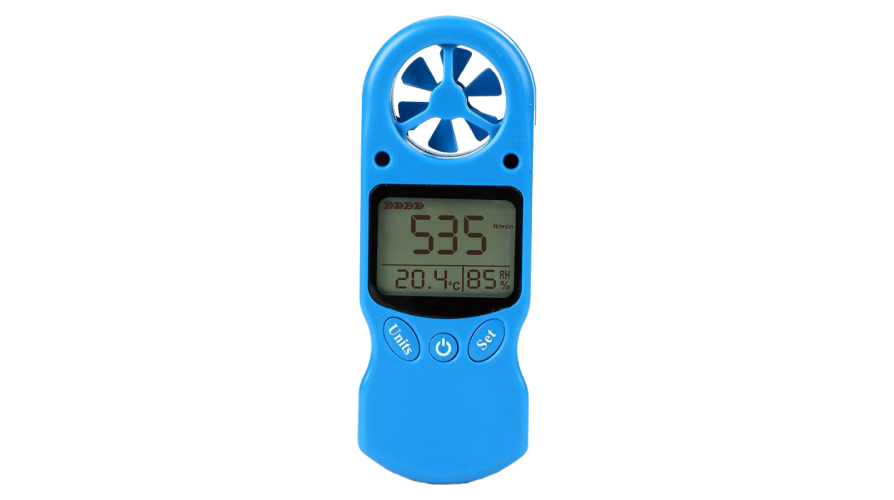Anemometer Innovations: The Latest Innovation for Wind Rate Measurement
Anemometer Innovations: The Latest Innovation for Wind Rate Measurement
Blog Article
All You Need to Find Out About Anemometers: How They Function, Why They Issue, and Where to Utilize Them
Anemometers, though often neglected in the realm of scientific instruments, play a critical duty in different areas, offering useful understandings right into wind rate and air flow patterns. As we delve into the intricacies of anemometer technology, we will certainly discover the internal operations of these gadgets, their importance, and the key considerations when choosing the best anemometer for particular applications.

Anemometer Basics
An essential tool made use of to measure wind speed and instructions, the anemometer plays a critical function in weather forecasting and various sectors. An anemometer typically contains 3 or 4 mugs that turn in the wind, a vane that points into the wind, and sensing units to track the rotations or movements. By calculating the turnings or movements over a certain time period, the anemometer can establish wind rate. The vane aids determine wind direction by pointing right into the wind, giving useful data for weather projecting, aviation, maritime procedures, ecological tracking, and wind energy applications.
There are different types of anemometers offered, including cup anemometers, vane anemometers, hot-wire anemometers, and sonic anemometers, each with its unique attributes and applications. Cup anemometers are generally utilized for fundamental wind speed measurements, while vane anemometers are preferred for directional measurements.
Principles of Anemometer Operation
Structure on the fundamental understanding of anemometer basics, the principles of anemometer operation elucidate the auto mechanics behind wind rate and direction measurements. Anemometers operate the concept of air movement impacting a sensor, creating it to revolve. Mug anemometers, as an example, have three or even more cups that catch the wind, creating them to spin much faster as the wind rate boosts. The rotation speed is then transformed right into a wind rate measurement. Vane anemometers, on the various other hand, make use of a tail or a probe that aligns itself with the wind instructions, offering a measurement of wind direction based upon the alignment of the sensing unit. Hot-wire anemometers depend on a heated wire that cools off as wind passes over it, with the price of cooling figuring out the wind speed. Ultrasonic anemometers step wind speed and direction by examining the time it considers ultrasonic signals to take a trip between transducers. Understanding these principles is critical for precise and browse around these guys dependable wind measurements in different applications.
Significance of Anemometers
Anemometers play an important duty in determining wind speed and instructions, providing important information for weather projecting, climate studies, ecological tracking, and aeronautics operations. Meteorologists count on anemometers to gather exact wind data, assisting them understand weather condition patterns, anticipate storms, and issue prompt cautions to the public. Wind farm operators make use of anemometers to examine wind problems and optimize electricity manufacturing from wind generators.
Applications Throughout Different Industries
In the sustainable energy field, anemometers play a vital role in examining wind conditions for wind farm placements, making certain ideal power production. Industries like construction and mining make use of anemometers to keep track of wind rates, critical for security protocols, specifically when functioning at elevations or in open-pit mines where strong winds can pose risks. In farming, anemometers help farmers in handling crop splashing by supplying real-time information on wind speed to avoid drift.

Selecting the Right Anemometer for Your Requirements
For basic objectives, a mug anemometer is suitable for measuring wind about his rate, while a vane anemometer supplies wind instructions data. Hot-wire anemometers are perfect for low airspeed dimensions, and ultrasonic anemometers use high precision and longevity.

Final Thought
To conclude, anemometers play an essential duty in measuring wind speed and direction throughout different industries. Comprehending the concepts of anemometer operation is vital for selecting the appropriate tool for details needs. From weather forecasting to air travel, anemometers are crucial tools for gathering precise information and making sure security in various applications. When selecting the most ideal device for measuring wind problems., it is vital to consider the value of anemometers in order to make informed choices.
There are various types of anemometers offered, including cup anemometers, vane anemometers, hot-wire anemometers, and sonic go to these guys anemometers, each with its special functions and applications. Mug anemometers are frequently used for fundamental wind speed dimensions, while vane anemometers are favored for directional measurements. Hot-wire anemometers are suitable for reduced airspeeds, and sonic anemometers are excellent for high-precision measurements in study and commercial settings.Building on the fundamental understanding of anemometer fundamentals, the principles of anemometer procedure elucidate the technicians behind wind speed and instructions dimensions. For basic purposes, a mug anemometer is suitable for measuring wind rate, while a vane anemometer provides wind direction data.
Report this page